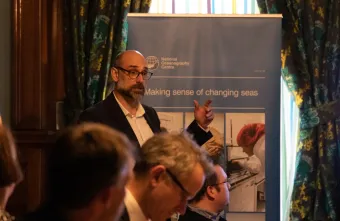
The National Oceanography Centre (NOC) recently led a stakeholder roundtable discussion on “Finding the common cause – how can developers and users collaborate on digital twins?”.
The discussion was part of the NOC-led “Information Management Framework for Environmental Digital Twins” (IMFe), a project co-funded by the Natural Environmental Research Council (NERC) and the Met Office.
The NOC’s Dr John Siddorn presented interim findings from the project, helping to frame a stakeholder debate on the future of digital twins. An environmental digital twin is a virtual representation of a system, updated from real-time data which uses simulation, machine learning and reasoning to help decision-making. With representatives from across academia, government and industry, participants at the event engaged in wide-ranging conversations about the importance of future collaboration to develop the potential of digital twins for the environment.
Commenting on the event, Dr John Siddorn, Associate Director Digital Ocean at the NOC, said: “There is huge potential for what digital twins can provide in a very practical sense – from monitoring the health of our marine environment to providing early warnings ahead of natural disasters on both land and sea. The IMFe project is key to developing a better understanding of what the building blocks for digital twins should look like. As part of the project, the roundtable discussion was useful in bringing together developers and users of digital twins. Collaboration requires us to build and sustain a community to take us to the next steps in this truly world-leading technology.”
The NOC is delivering this project in partnership with the British Geological Survey, the Centre for Environmental Data Analysis, and the UK Centre for Ecology & Hydrology. The project, endorsed by the British Antarctic Survey, the Centre for Digital Built Britain, and the National Centre for Atmospheric Science, will deliver the Roadmap for developing an Information Management Framework for the Environment to be used consistently across a range of digital twins.